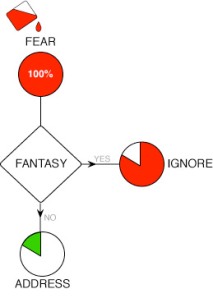It seems that there are a lot of Scrum Masters having trouble with their Retrospectives, either they don’t get any real commitment from the Team or they seem to think that they need to have all the answers (which of course is not true) for any questions that might come up during the session. The simple advice would of course be to read the brilliant book Agile Retrospectives (by Esther Derby and Diana Larsen) to find laods of inspiration and great activities to use during your Retrospective. Another way could be to use the Retrospective as an opportunity to excercise your coaching skills and use the T-GROW model to guide the Team through the retrospective. I have tried it on a couple of occassions and it has worked really well. I think it is a good thing to try different things out, to avoid boredom as well as to learn new stuff.
T-GROW stands for Topic, Goal (for the session), Reality, Options and Wrap-up and is commonly used as a structure for a one-on-one coaching session where it is the coachee who brings a topic to the session. Here’s how I have used the model to coach a Team during a Retrospective:
Topic
The first thing you need to do is to establish what the Retrospective will address. In a Team coaching situation I let the Team do some initial brainstorming to find a common topic they think we should be focusing on (see the post on Creative Processes). Simply let the Team bring up a lot of ideas (divergence) on sticky notes and have them put dots on those they find urgent or interesting (convergence). Another way of doning this could simply be to suggest a topic if you have noticed some problem you think would be important to find a solution to (this is not done in one-on-one coaching). Make sure that the Team really agrees with your observation though, otherwise you risk ending up in a blame game situation.
Goal
The Goal for the session, that is what result do the Team want after the retrospective. It might be a simple goal as “we want to understand why we have so many defects”, “we want to find a way to increase team morale” or simply “we need a better way of writing requirements”. The important thing is that the goal is something that is achievable in the amount of time you have for the Retrospective and that it is something that the entire Team agreees on. I simply ask the Team for suggestions instead of doing a brainstorming session.
Reality
This is where you ask the Team to describe the reality as they understand it, the aspects of the problem or the effects of it. The purpose of it all is to get a common understanding of whatever the Goal aims for. Sometimes I chip in here, but I always try to share observations not conclusions. The role of the coach here is to ask clarifying questions and make sure that everyone is heard and that any disagreements about anything are solved vefore moving on.
Options
What options do the Team have to achieve the Goal of the session, to change their reality according to their Goal? There might be different parts of Reality that could be changed to achieve the Goal or there could be different approaches to change the same part of Reality. The coachs role here is to help the team find out what they themselves can change and what they might need help with from the organisation. This is also a creative process, go for a lot of solutions and then reduce the ideas to a manageable amount.
Wrap-Up
This is where you get a commitment from the Team – of all the options they have, what are they willing to try out? If it is a complex solution you might need to detail it a bit further before closing the Retrospective, you want to iron out all the wrinkles before you’re done.
You might want to read up on the T-GROW model before trying this out, just remember that it is not a real coaching session and that you are allowed to make mistakes and ask your Team if you get stuck!

Recent Comments